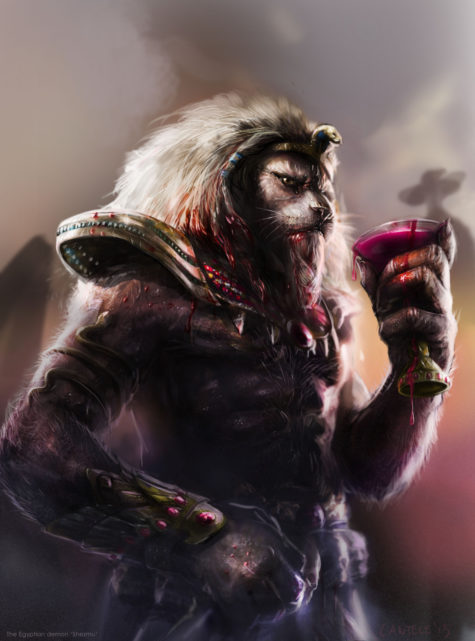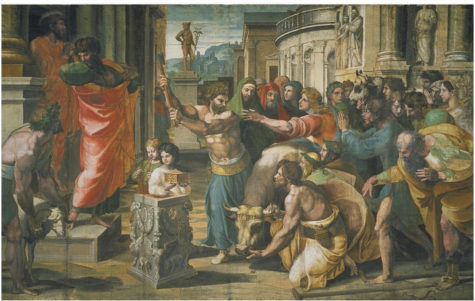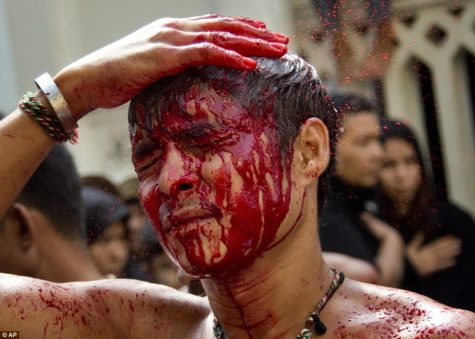Blood

February 17 is the Feast of Shesmu, Eqyptian god of execution, slaughter, blood, embalming oil, wine, and perfume. Old Kingdom texts mention a special feast celebrated for Shesmu: young men would press grapes with their feet and then dance and sing for Shesmu.
Shesmu is also known as:
- Shezmu, Schezemu, Schesmu, Shesemu, Shezmou, Shesmou, Sezmu and Sesmu.
Shesmu was a god with a contradictory personality. On one hand, he was lord of perfume, maker of all precious oil, lord of the oil press, lord of ointments and lord of wine; a celebration deity.
On the other hand, Shesmu was very vindictive and bloodthirsty. He was also lord of blood, great slaughterer of the gods and he who dismembers bodies. In Old Kingdom pyramid texts several prayers ask Shesmu to dismember and cook certain deities in an attempt to give the food to a deceased king. The deceased king needed the divine powers to survive the dangerous journey to the stars.
Shesmu had the head, fangs, and mane of a lion drenched in blood, and he wore human skulls around his waist. He could form into a man or falcon.
Shezmu did away with bad people, putting their heads through winepresses, draining them of their blood and turning it into wine on the order of Osiris. The bodies and blood of the dead gave sustenance for Unas, Pharaoh of Ancient Egypt, and the last ruler of the Fifth dynasty from the Old Kingdom.
Due to its color, red wine became strongly identified with blood, and thus Shezmu was identified as lord of blood. Since wine was seen as a good thing, his association with blood was considered one of righteousness, making him considered an executioner of the unrighteous, being the slaughterer of souls. When the main form of execution was by beheading, it was said that Shezmu ripped off the heads of those who were wicked, and threw them into a wine press, to be crushed into red wine, which was given to the righteous dead.
Beheading was commonly carried out by the victim resting their head on a wooden block, and so Shezmu was referred to as Overthrower of the Wicked at the Block. This violent aspect lead to depiction, in art, as a lion-headed man, thus being known as fierce of face.
In later times, Egyptians used the wine press for producing oils instead of wine, which was produced by crushing under foot instead. Consequently, Shezmu became associated with unguents and embalming oils, and thus the preservation of the body, and of beauty.
The violent character of Shesmu made him a protector among the companions of Ra’s nocturnal barque. Shesmu protected Ra by threatening the demons and brawling with them.
Shezmu followed the commands of The God of The Dead. Though he seemed a fierce underworld deity, he offered protection to the virtuous. Shezmu offered red wine to those who had passed on.
The feast is no longer celebrated, but most Ancient Egyptian feasts were religious in nature. Bread, cakes, wine/beer, meat, and fowl would have been consumed, incense burned, and prayers offered to Shesmu.
Sources:
The 23rd of August marks the Ancient Greek holiday of Nemesia, – the festival of the Goddess Nemesis – the Goddess of Fate, Revenge, and Divine Retribution. Blood sacrifices were traditional on this day.
- Note: According to some sources the Nemesia fell on August 21.
This purpose of this festival was to ‘avert the nemesis of the dead’ in order that they could steer away the suffering or punishment of the living.
The goddess Nemesia, very basically, is the Spirit of Retribution against one’s own arrogance before the gods. Because she had this dual-nature, being both fortune and retribution, the Cults would celebrate in her honor to make sure they did not face her fury and could indeed have the gifts of fortune bestowed upon them. In many cases, she was worshiped by generals and gladiators who would pray for strength in combat. But surely this was not all.
She was invoked against those whose hubris and arrogance got the better of them, and served as a force of divine reckoning. She also appears in both Greek and later Roman mythology as an avenging force protecting those who have been violently wronged by their lovers. During the Imperial period of Rome, Nemesis was adopted as a patroness of victorious generals, and of gladiators entering the arena.
The Cult of Nemesia was later associated with Fortuna in Imperial Rome, the cult of Nemesis-Fortuna, which honored Nemesis as the deliberate balance to the random chance of Fortuna’s selections.The all-powerful Nemesia-Fortuna was worshiped by the Freemen of Hadrian and was considered to have a dual-nature about her.
This dual-nature in Nemesia is something which seems to me symbolic of our human nature. We have this spirit of fortune but also this spirit of retribution within us. At least I do.
Sources: State of Information and Pagan Wiccan
Dies Sanguinis (Day of Blood) was a festival held in Ancient Rome on 24 March. Also known as Bellona’s Day, this was an occasion when the Roman votaries of the war-goddess Bellona cut themselves and drank this sacrificial blood to propitiate the deity.
The worship of this asiatic goddess was introduced into Rome apparently by Sulla, to whom she had appeared, urging him to march to Rome and bathe in the blood of his enemies.
Note: She should not be mistaken for the Roman Bellona, whose festival, which was largely a huge feast, took place on the 3rd of June.
For her a new temple was built, and a college of priests (Bellonarii) instituted to conduct her fanatical rites, the prominent feature of which was to lacerate themselves and sprinkle the blood on the spectators. To make the scene more grim they wore black dresses (Tertullian, De Pallio) from head to foot.
The Priests of Bellona (also known as Bellonarii) practiced other rituals on Dies Sanguinis, one rite being to mutilate their own limbs, such as their own arms and legs with a sharp knife or knives in order to collect their own blood to either drink, or offer to their goddess Bellona in order to get her to invoke her war fury on them. In some instances, they would even drink their own blood in hopes that Bellona would grant a warlike frenzy.
An ancient source about Dies Sanguinis is in a book called “Apologeticum” by an early Roman Christian who states:
“on the sixteenth before the Kalends of April, that most sacred high priest of hers was offering, a week after, impure libations of blood drawn from his own arms…”
There also a plant known as the Bellonaria plant (solanum). Which is a corruption on the name Belladonna, a deadly nightshade, was used by priests at this festival, Dies Sanguinis.
When a priest ate its seeds, they would start to hallucinate. Those hallucinations were used by them to make prophetic and oracular statements in the name of their goddess.
Collected from various sources.






